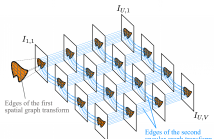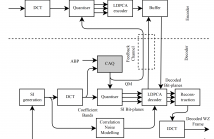
- Read more about FAST 3D-HEVC DEPTH MAPS INTRA-FRAME PREDICTION USING DATA MINING
- Log in to post comments
This paper presents a fast 3D-High Efficiency Video Coding (3D-HEVC) depth maps intra-frame prediction based on static Coding Unit (CU) splitting decisions trees. This coding approach uses data mining to extract the correlation among the encoder context attributes and to define a split decision tree for each CU level of the depth maps encoding. The decision trees were trained using the information extracted from 3D-HEVC Test Model (3D-HTM) and using the Common Test Conditions (CTC).
- Categories:
 25 Views
25 Views
- Read more about CLUSTER-BASED POINT CLOUD CODING WITH NORMAL WEIGHTED GRAPH FOURIER TRANSFORM
- Log in to post comments
Point cloud has attracted more and more attention in 3D object representation, especially in free-view rendering. However, it is challenging to efficiently deploy the point cloud due to its huge data amount with multiple attributes including coordinates, normal and color. In order to represent point clouds more compactly, we propose a novel point cloud compression method for attributes, based on geometric clustering and Normal Weighted Graph Fourier Transform (NWGFT).
- Categories:
 133 Views
133 Views
- Read more about An efficient deep convolutional laplacian pyramid architecture for CS reconstruction at low sampling ratios
- Log in to post comments
The compressed sensing (CS) has been successfully applied to image compression in the past few years as most image signals are sparse in a certain domain. Several CS reconstruction models have been proposed and obtained superior performance. However, these methods suffer from blocking artifacts or ringing effects at low sampling ratios in most cases. To address this problem, we propose a deep convolutional Laplacian Pyramid Compressed Sensing Network (LapCSNet) for CS, which consists of a sampling sub-network and a reconstruction sub-network.
- Categories:
 14 Views
14 Views
- Read more about OCTAGONAL-AXIS RASTER PATTERN FOR IMPROVED TEST ZONE SEARCH MOTION ESTIMATION
- Log in to post comments
Test Zone Search (TZS) is considered the current state-of-the-art fast Motion Estimation algorithm because it presents
- Categories:
 14 Views
14 Views
- Read more about FAST TEXTURE INTRA SIZE CODING BASED ON BIG DATA CLUSTERING FOR 3D-HEVC
- Log in to post comments
- Categories:
 11 Views
11 Views
- Read more about GRAPH-BASED TRANSFORMS FOR PREDICTIVE LIGHT FIELD COMPRESSION BASED ON SUPER-PIXELS
- Log in to post comments
In this paper, we explore the use of graph-basedtransforms to capture correlation in light fields. We consider a scheme in which view synthesis is used as a first step to exploit inter-view correlation. Local graph-based transforms (GT) are then considered for energy compaction of the residue signals. The structure of the local graphs is derived from a coherent super-pixel over-segmentation of the different views. The GT is computed and applied in a separable manner with a first spatial unweighted transform followed by an inter-view GT.
- Categories:
 13 Views
13 Views
- Read more about PRECODING MATRIX DESIGN IN LINEAR VIDEO CODING
- Log in to post comments
- Categories:
 13 Views
13 Views
- Read more about Transform Domain Distributed Video Coding Using Larger Transform Blocks
- Log in to post comments
- Categories:
 22 Views
22 Views- Read more about Virtual Reality Content Streaming: Viewport-Dependent Projection and Tile-based Techniques
- Log in to post comments
- Categories:
 42 Views
42 Views- Read more about HIGHLY PARALLEL HEVC MOTION ESTIMATION BASED ON MULTIPLE TEMPORAL PREDICTORS AND NESTED DIAMOND SEARCH
- 3 comments
- Log in to post comments
Rate-constrained motion estimation (RCME) is the most computationally intensive task of H.265/HEVC encoding. Massively parallel architectures, such as graphics processing units (GPUs), used in combination with a multi-core central processing unit (CPU), provide a promising computing platform to achieve fast encoding. However, the dependencies in deriving motion vector predictors (MVPs) prevent the parallelization of prediction units (PUs) processing at a frame level.
- Categories:
 46 Views
46 Views